Stem or Root Problems
Enlarged or deformed roots
Cause
Club root (Plasmodiophora brassicae), a fungal-like disease.
Treatment
Rotate crops annually, avoid planting sites where other cole crops were grown in the previous year. Club root outbreaks are worse in wet and acidic soils. In low pH soils, the addition of lime may be helpful. Approved fungicides may be available. Contact your chemical supplier or local Extension agent for the latest fungicide recommendations.
Stem Cankers
Cause
Black leg (Phoma lingam), a fungal disease. Cankers usually appear at the base of stem. As the disease progresses yellow leaf spots develop.
Treatment
Rotate crops annually and remove crop debris. Avoid planting sites where other cole crops were grown in the previous year. Disease resistant varieties and disease free seed are available.
Leaf or head problems
Yellow leaves with black veins
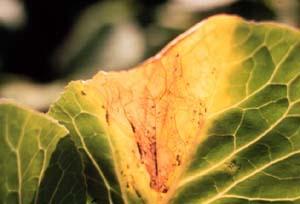
Cause
Black rot (Xanthomonas campestris), a bacterium that enters pores at leaf edges.
Treatment
Rotate crops annually, avoid planting sites where other cole crops were grown in the previous year. Remove crop debris each season and avoid planting in areas prone to runoff from adjacent compost piles.
Dark leaf spots
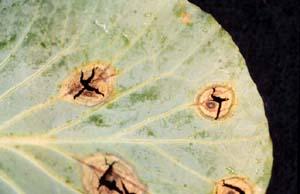
Cause
Alternaria (Alternaria brassicae), a fungal disease. The small dark spots characteristic of this disease enlarge over time and are especially noticeable on the heads of broccoli and cauliflower.
Treatment
Rotate crops annually, avoid planting sites where other cole crops were grown in the previous year. Remove crop debris each season. Disease-free seed and copper-based fungicides are available.
White, fluffy mold on leaf undersides
Cause
Downy mildew (Peronospora parasitica) a fungal disease which is worse in cool and moist conditions.
Treatment
Resistant varieties and fungicides are available. Also avoid excessive overhead irrigation and space rows adequately to ensure proper air circulation between plants.
Curling, deformed, or yellow leaves with a shiny or sticky substance on surfaces
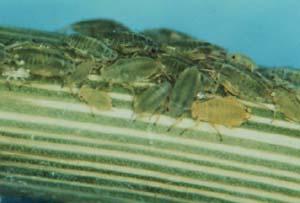
Cause
Aphids, especially the cabbage aphid (Brevicoryne brassicae). These small soft-bodied insects are less than 1/8 inch long and appear in a variety of colors. Using piercing-sucking mouth parts, aphids remove plant sap and often spread disease in the process. Ants are often drawn to their sticky excrement.
Treatment
Treatment is usually not required as many natural predators such as lady beetles exist. However in widespread infestations (more than 50% of all leaves in field infested), action may be necessary. Low toxicity insecticidal soaps and horticultural oils are highly effective.
Leaf holes, skeletonization, or chewed leaf margins
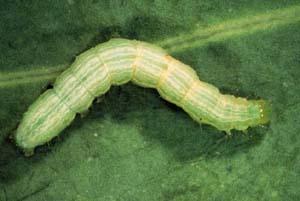 |
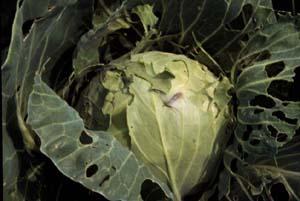 |
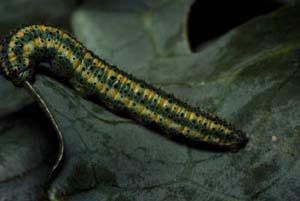 |
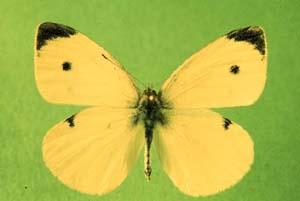 |
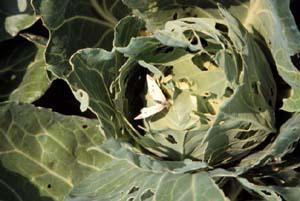 |
Cause
Caterpillars, various species including: The cabbage looper (Trichoplusia ni), the imported cabbageworm (Pieris rapae), and the diamondback moth (Plutella xylostella).
Feeding damage of these and other caterpillars is characterized by chewing of leaf or fruit surfaces sometimes accompanied by dark green or black droppings. Individual color patterns of caterpillars can vary, and the green color of many species makes them difficult to spot.
Treatment
Remove caterpillars by hand in small plantings. In large plantings, use approved formulations of Bt. Apply these pesticides when caterpillars are young and small if possible, and when populations exceed 0.5 caterpillars per plant.
Small leaf holes
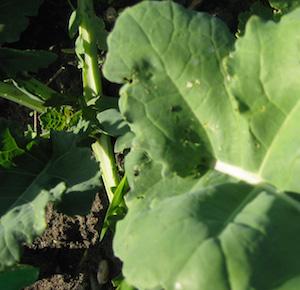
Cause
Flea beetles (various species).
Treatment
Fruit is rarely damaged. Treatment is usually not required. Control by eliminating weeds near field edges, and eliminating overwintering sites by removing crop residue